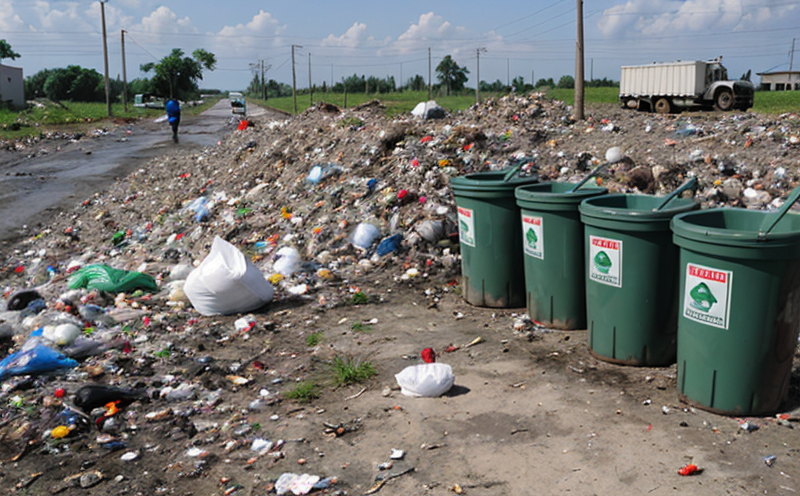EN 16171 Heavy Metals in Solid Waste Test
The EN 16171 standard provides a robust framework for the determination of heavy metals in solid waste. This method is crucial for ensuring that waste materials meet environmental and regulatory standards, thereby protecting public health and the environment.
This test is particularly important as it helps identify potential sources of contamination from waste, such as lead, cadmium, mercury, chromium, and other hazardous substances. These heavy metals can be harmful if released into the ecosystem or consumed by humans and animals. The test ensures that waste materials are handled safely and responsibly.
The EN 16171 standard is applicable to various types of solid waste, including municipal solid waste (MSW), construction and demolition waste, industrial waste, and hazardous waste. It is designed to be used in laboratory settings where precise analysis is required. The testing process involves several steps:
- Sample collection: Representative samples are collected from the waste material.
- Sample preparation: Samples are dried, homogenized, and ground into a fine powder.
- Inductively Coupled Plasma Mass Spectrometry (ICP-MS): This technique is used to detect heavy metals in the sample. It involves introducing the prepared sample into an ICP-MS instrument where it is vaporized and ionized before being analyzed for metal content.
The results are reported in terms of weight per unit mass of the waste material, typically expressed as parts per million (ppm). Compliance with regulatory limits set by standards like EN 16171 ensures that waste can be processed or disposed of safely and effectively. This is especially important for waste destined for landfills or recycling processes.
The test results are vital for quality managers, compliance officers, R&D engineers, and procurement teams involved in managing solid waste. They provide critical insights into the environmental impact of waste materials and help guide decisions on waste management strategies. By adhering to EN 16171 standards, organizations can ensure they meet their sustainability goals while complying with international regulations.
The application of this standard is not just limited to waste management but also extends to various sectors such as construction, manufacturing, and environmental engineering. In these areas, the accurate identification of heavy metals in solid waste helps prevent contamination of soil, water bodies, and air.
Applied Standards
| Standard Name | Description | Scope |
|---|---|---|
| EN 16171:2015 | Determination of heavy metals in solid waste—Inductively coupled plasma mass spectrometry (ICP-MS) method | This standard provides a methodology for the determination of heavy metals such as lead, cadmium, mercury, chromium, and others in solid waste using ICP-MS. |
| ISO 17025:2017 | General requirements for the competence of testing and calibration laboratories | This international standard ensures that the laboratory performing EN 16171 tests operates in a manner consistent with internationally recognized best practices. |
| ASTM D3954 | Determination of total chromium in solid waste by ion chromatography | This American Society for Testing and Materials standard provides an alternative method to EN 16171 for determining chromium content, which is one of the heavy metals tested under EN 16171. |
The use of these standards ensures that the testing process is accurate, reliable, and consistent across different laboratories. This consistency is critical in maintaining high-quality results and ensuring compliance with international regulations.
Quality and Reliability Assurance
- Trained and certified analysts: Our team of experts undergo continuous training to stay updated on the latest testing methodologies and standards.
- Laboratory accreditation: We are accredited by recognized bodies such as ISO 17025, ensuring our laboratory practices meet international quality requirements.
- Regular equipment calibration: All instruments used in EN 16171 tests are regularly calibrated to ensure accurate measurements.
- Detailed record-keeping: Comprehensive records of each test are maintained, facilitating traceability and reproducibility.
The combination of these quality assurance measures ensures that the results from our laboratory are reliable and can be trusted by clients across various industries. Our commitment to accuracy and precision is what sets us apart in the field of environmental testing.
Competitive Advantage and Market Impact
The ability to accurately and reliably determine heavy metals in solid waste using EN 16171 provides significant competitive advantages for businesses involved in waste management, recycling, and environmental compliance. Here are some key benefits:
- Regulatory Compliance: Ensures that all waste materials meet the regulatory standards set by various international and national authorities.
- Sustainability: Helps companies demonstrate their commitment to sustainability by minimizing environmental impact.
- Risk Management: Identifies potential risks associated with waste disposal, allowing for proactive measures to be taken.
- Reputation Enhancement: Building a reputation for reliability and accuracy in testing can enhance the company’s standing within the industry.
The market impact of accurate heavy metal testing is profound. It not only ensures compliance but also promotes trust among stakeholders, including regulatory bodies, customers, and the general public. By adhering to EN 16171 standards, companies can contribute positively to environmental conservation efforts.





